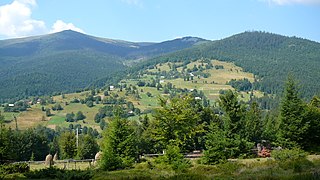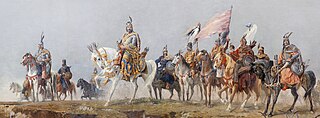
Austria-Hungary, often referred to as the Austro-Hungarian Empire or the Dual Monarchy, was a constitutional monarchy in Central and Eastern Europe from 1867 to 1918. It was formed by giving a new constitution to the Austrian Empire, which devolved powers on Austria (Cisleithania) and Hungary (Transleithania) and placed them on an equal footing. It broke apart into several states at the end of World War I.

Hungary is a country in Central Europe. Spanning 93,030 square kilometres (35,920 sq mi) in the Carpathian Basin, it borders Slovakia to the north, Ukraine to the northeast, Austria to the northwest, Romania to the east, Serbia to the south, Croatia to the southwest, and Slovenia to the west. With about 10 million inhabitants, Hungary is a medium-sized member state of the European Union. The official language is Hungarian, which is the most widely spoken Uralic language in the world. Hungary's capital and largest city is Budapest. Other major urban areas include Debrecen, Szeged, Miskolc, Pécs and Győr.

Hungarian is a Finno-Ugric language spoken in Hungary and parts of several neighbouring countries. It is the official language of Hungary and one of the 24 official languages of the European Union. Outside Hungary it is also spoken by communities of Hungarians in the countries that today make up Slovakia, western Ukraine (Subcarpathia), central and western Romania (Transylvania), northern Serbia (Vojvodina), northern Croatia and northern Slovenia. It is also spoken by Hungarian diaspora communities worldwide, especially in North America and Israel. Like Finnish and Estonian, Hungarian belongs to the Uralic language family. With 13 million speakers, it is the family's largest member by number of speakers.

Transylvania is a historical region which is located in central Romania. Bound on the east and south by its natural borders, the Carpathian mountain range, historical Transylvania extended westward to the Apuseni Mountains. The term sometimes encompasses not only Transylvania proper, but also parts of the historical regions of Crișana and Maramureș, and occasionally the Romanian part of Banat.

Budapest is the capital and the most populous city of Hungary, and the tenth-largest city in the European Union by population within city limits. The city had an estimated population of 1,752,704 in 2016 distributed over a land area of about 525 square kilometres. Budapest is both a city and county, and forms the centre of the Budapest metropolitan area, which has an area of 7,626 square kilometres and a population of 3,303,786, comprising 33 percent of the population of Hungary.
The Hungary national football team represents Hungary in international football and is controlled by the Hungarian Football Federation.

The Kingdom of Hungary was a monarchy in Central Europe that existed from the Middle Ages into the 20th century. The Principality of Hungary emerged as a Christian kingdom upon the coronation of the first king Stephen I at Esztergom around the year 1000; his family led the monarchy for 300 years. By the 12th century, the kingdom became a European middle power within the Western world.

Somogy is an administrative county in present Hungary, and also in the former Kingdom of Hungary.
IRWIN is a collective of Slovenian artists, primarily painters, and an original founding member of Neue Slowenische Kunst (NSK).
The 2002 Women's Hockey Champions Challenge was the inaugural edition of the field hockey championship for women. It was held in Johannesburg, South Africa from February 9–17, 2002.
Arns is a surname. Notable people with the surname include:

The Ancre is a river of Picardy, France. Rising at Miraumont, a hamlet near the town of Albert, it flows into the Somme at Corbie. It crosses no départements other than the Somme.

Hungarians, also known as Magyars, are a nation and ethnic group native to Hungary and historical Hungarian lands who share a common culture, history and language. Hungarians belong to the Uralic-speaking peoples. There are an estimated 14.2–14.5 million ethnic Hungarians and their descendants worldwide, of whom 9.6 million live in today's Hungary. About 2.2 million Hungarians live in areas that were part of the Kingdom of Hungary before the Treaty of Trianon and are now parts of Hungary's seven neighbouring countries, especially Slovakia, Ukraine, Romania, Serbia, Croatia, Slovenia and Austria. Significant groups of people with Hungarian ancestry live in various other parts of the world, most of them in the United States, Canada, Germany, France, the United Kingdom, Brazil, Australia, and Argentina. Hungarians can be classified into several subgroups according to local linguistic and cultural characteristics; subgroups with distinct identities include the Székelys, the Csángós, the Palóc, the Matyó and the Jász people, the last being considered an Iranic ethnic group being closely related to the Ossetians.
Inke Arns is a German curator and theorist known for her works focusing on media arts.
Tartar Invasion is a 1917 Hungarian drama film directed by Michael Curtiz.
Mattie the Goose-boy is a 1977 Hungarian animated film directed by Attila Dargay. It is based on the eponymous poem, written in 1804 by Mihály Fazekas.
Inke van Wyk is a South African former field hockey player who competed in the 2000 Summer Olympics.
Stars of Eger is a 1968 Hungarian historical film directed by Zoltán Várkonyi and starring Imre Sinkovits, György Bárdy and István Kovács. It is an adaptation of the 1899 novel Eclipse of the Crescent Moon by Géza Gárdonyi. An earlier silent film adaptation, Stars of Eger, was made in 1923. "Stars of Eger" is a direct translation of the original Hungarian title of the novel.
The Frozen Child is a 1921 Hungarian silent drama film directed by Béla Balogh and starring Mária Szepes, Ferenc Szécsi, Anna Breznay and Viktor Galánthay. It is one of the few surviving Hungarian films of the early 1920s. It was unusual for its depiction of poverty in Hungary at a time when this was discouraged or censored by the authorities.

Csurgó is a district in south-western part of Somogy County. Csurgó is also the name of the town where the district seat is found. The district is located in the Southern Transdanubia Statistical Region.













